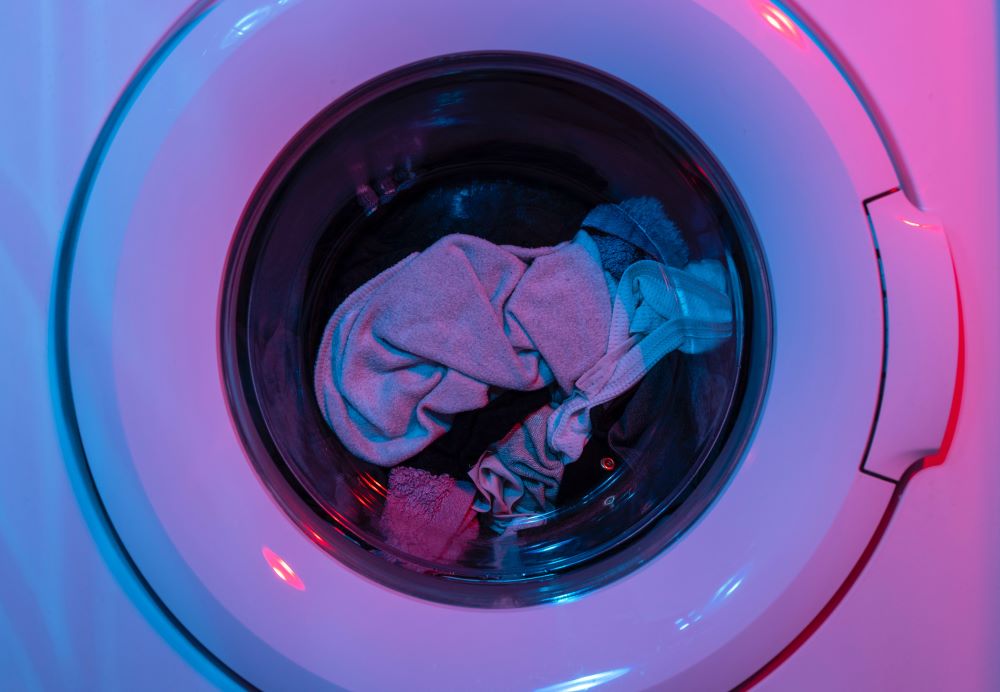You have items in your wardrobe that contain synthetic fibers. Do you love some of them so much and just can’t part with them…yet?
That may leave you wondering how you can reduce the amount of microfibers you’re sending on down to the ocean.
Here are two things you can do to reduce how much microfiber shedding your laundry does. This is part two of five steps you can take to reduce your microfiber footprint.
Wash your clothing less
Most of us wash our clothes way too often. Each washing wears the clothing out faster. It consumes clean water and electricity unnecessarily. And it sheds more microfibers into the environment.
I grew up not washing many things after one wearing. If it wasn’t actually dirty we’d hang it up and wear it again until it was dirty, by looks or by smell. (Underwear and socks being the exception!)
I was given a little old-fashioned booklet in the fifth grade about growing up and being lady-like 🙂 . It taught me to air my clothes after each wearing by draping my garments over a chair overnight or hang them on a hanger in an airy spot to air them out. Then hang them up in a closet. This is what I did.
And we’d each use one bath towel each week before washing them. We’d be sure to allow them to dry out each day.
But somewhere along the line younger generations started washing things after every use, including bath towels.
I got a taste of this during a visit at a relative’s house where two teens lived. I used a towel one day expecting to use it again the next day. But the next day it was gone. I got a fresh one and the same thing happened again. I thought it strange. Living in California where water use is always an issue, I thought this was very wasteful.
And since then I’ve become much more aware of how microfibers are affecting our planet, especially oceans and ocean life.
Since so much of our laundry contains synthetic fibers which shed when we wash them, washing less will help reduce our microfiber impact on the planet.
Even Levi’s thinks we should wash less to help the planet

That’s right. The CEO of Levi’s, Chip Bergh, doesn’t wash his jeans. At all. He does spot clean them, though. And hand washes if necessary. Levi’s has found that 23% of the water used over the life of a pair of jeans, from manufacture to trash, is in consumer washing. So if you wash less…you’re using less water and you’re making your jeans last longer! (Source)
Some Levi’s jeans, especially women’s, have synthetic fibers. All brands do. So washing them contributes to the microfiber problem. But Levi’s makes do 100% cotton fiber women’s jeans again now!! Get those instead if you want to reduce your microfiber impact. I love mine.
Some scientific data to back up this idea
A PhD student at RMIT in Australia asked a group of 30 students to wear the same pair of jeans at least five days a week for three months, without washing them. The students reported that after three months they weren’t visibly dirty nor were they smelly. (Source)
In other studies microbiologists have found the microbe count to be surprisingly low on jeans after being worn and unwashed for 15 months. The bacteria present were all the normal sorts. (Source).
“The more you wash your jeans, the more worn they’ll look. If you’re trying to preserve the appearance of denim, you should only wash jeans—and I know this sounds gross—when they start to smell. The fact is that microbes found on jeans after you wear them (skin cells, natural oils, etc.) are harmless, making frequent washing unnecessary.”
Lana Blanc, personal fashion stylist, NYC
You can find plenty of guides online to help you decide how often you should wash different types of garments. Here’s one guide one for reference. (Source) But keep in mind, most of them will guide you to a high frequency of washing. Many are concerned with bacteria build-up. But you may get away with a much lower frequency as the Levi’s CEO did.
Go ahead, push the envelope and experiment. Jeans shouldn’t be the exception, most of our laundry can be washed less.
Others weigh in on washing garments
In an article from the BBC, fashion designer Stella McCartney, was said to advocate for not using a washing machine. One reason was to take better care of our clothes and increase their longevity. The other, to reduce the environmental impact this washing has on the environment.
In the same article, Professor Andrew Groves, fashion design head at the University of Westminster, explains that the friction in the washing machine distorts the garments’ shape and color. He adds, that the better you care for your clothes, the longer they last, and the more sustainable your fashion is. (And doesn’t that save money!)
Buying less clothing over the long term is more sustainable, and less washing reduces microfiber shedding into your laundry wastewater.

What can you do instead of washing?
Air them out.
Spot clean.
Hand wash.
Wash only when they need it….and, when they need washing…
How to wash better to reduce microfibers in your wastewater
Washing better and adding microfiber filters to your laundry process will help significantly.
- Wash with cold water: it reduces microfiber shedding from your clothes.
- Use front loading machines instead of top loading: this creates less friction for the fabrics, which reduces microfiber shedding. If you don’t have one already, choose that type when you need a replacement.
- Line dry laundry as much as you can: this makes clothes last longer and reduces microfiber shedding. Microfibers from dryers end up in your home’s air or backyard, or wherever your vent sends it. When you do use the dryer PLEASE dispose of the lint in the trash, in a plastic bag so it doesn’t get spread into the air (apparently some people wash it down the drain???!!!).
- Liquid detergent is said to make less friction than powdered… but:… my opinion is that it’s a sorry thing that the now-old fashioned, recyclable, biodegradable cardboard boxes of laundry detergent powder have disappeared from most store shelves. I think liquid detergent is it’s not the best choice—at all. Think of all those plastic liquid soap bottles and the extra weight to ship them which uses more fossil fuels which generates more CO2 emissions. Instead, dissolve the powder in hot water and add to the washer. I’ll stick with the powder detergent and take the little extra step to dissolve it before adding it to the washer.
- Wash for a shorter duration: Less time in the washer means less chance for the fibers to break.
- Use full loads in your washing machine: this results in less friction between clothes.
- Avoid laundry pods: the pod casing is plastic which dissolves and goes out into the waterways or through your septic system into the ground.
- Use less detergent.
- Choose from an array of laundry filters and devices that reduce microfiber shedding and reduce their escape into the waterways.
But do wash when germs are a real threat to your family’s health.
Remember just a couple of years ago when we weren’t yet clear on how Covid spread? We wanted to wash clothing to prevent any spreading of the disease. In cases like that this guide from WebMD would be handy.
But under normal conditions, return to the option of reducing the microfiber pollution from your laundry by simply washing less.

Are you convinced?
It’s ok to wash less! See how long you can get away with it for different garments. If you air out your clothes after each wearing and then hang them in an airy closet, rather than dropping them on the floor or throwing them straight into the hamper, you can start to determine how much you really need to wash your clothing and when.
Washing your clothes less will save you time and money. But it will also save your clothes so you can buy less—which is more sustainable. And it reduces the microfiber pollution your laundry makes.
You’re helping the oceans, the animals of the ocean, and the whole planet.
One less wash at a time.
Here’s more you can do:
Watch The Story of Microfibers video.
Sign a petition from Stop Plastic Microfiber Pollution! from to tell fashion designers to choose natural fibers.
Related Reading:
How to Reduce Plastic Microfibers from Your Laundry Wastewater
Buy Less Clothing, Reduce Your Wardrobe’s Microfiber Pollution-Here’s Why
What are microfibers? Where do they come from? Why are they a problem?
Microplastic: The Most Insidious Plastic Problem
Plastics in Oceans: They’re in Every Corner of the Earth
Organizations that Work to Help Solve the Plastics in Oceans Problem

